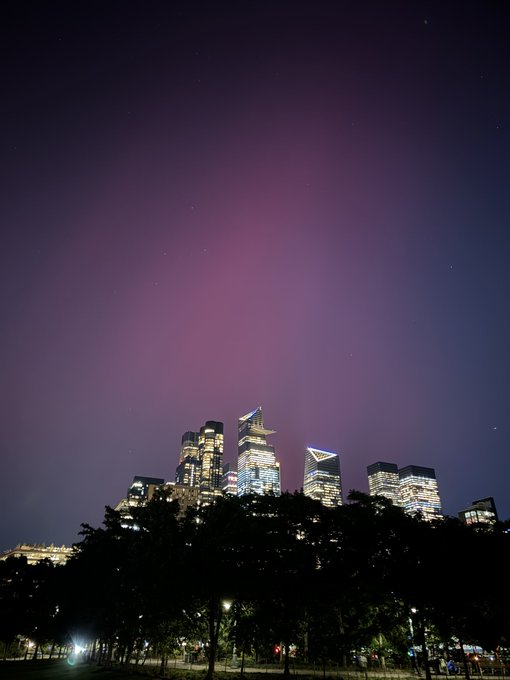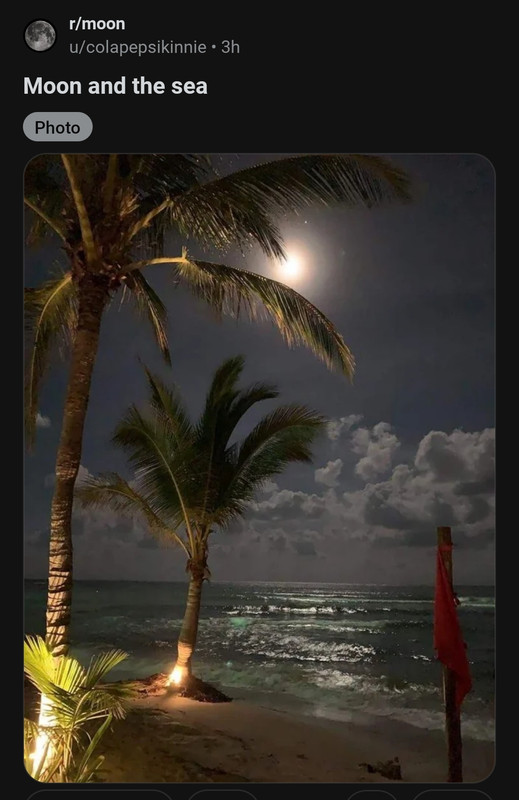-
SCAM WARNING! See how this scam works in Classifieds.
You are using an out of date browser. It may not display this or other websites correctly.
You should upgrade or use an alternative browser.
You should upgrade or use an alternative browser.
I just saw the moon
- Thread starter TheMadDabber
- Start date
CrazyDiamond
HAL is a StarChild
I'm not looking forward to that beasty 
CrazyDiamond
HAL is a StarChild
It's 10:15 pm here and it's been pouring rain and howling wind outside for a while now....so far so good. I hope all the other peeps that frequent this thread who are from Florida are doing well too, and everyone in it's path.
florduh
Well-Known Member
Well. I don't live in FL full time anymore. But I happened to be here this week visiting my folks. Kind've wanted to fly out when I saw this fucker brewing, but decided to stay. And I'm glad I did because their property was a mess of potential missiles and my dad is fat and in his mid 60's so I was able to help batten that shit all down.
They're in central Florida and not even projected to get a direct hit. We just lost power and I went outside to fire up the generator. Winds are gusting to 50-60 mph...and I gotta tell you, the rain felt like it was stripping off my goddamn skin.
We're not even in the worst of it yet. Scheduled to get gusts up to 90-100mph in a few hours. Can't really imagine being outside in that shit. Definitely feel bad for the people getting a direct hit. Stay safe everyone!
They're in central Florida and not even projected to get a direct hit. We just lost power and I went outside to fire up the generator. Winds are gusting to 50-60 mph...and I gotta tell you, the rain felt like it was stripping off my goddamn skin.
We're not even in the worst of it yet. Scheduled to get gusts up to 90-100mph in a few hours. Can't really imagine being outside in that shit. Definitely feel bad for the people getting a direct hit. Stay safe everyone!
CrazyDiamond
HAL is a StarChild
florduh
Well-Known Member
I hate this shit.
Yeah me too. Stay safe, dude.
Probably for the best that the Rays ate shit and didn't make the playoffs
Though I'm pretty sure Tropicana was being used as a shelter

Keeping things Space-Friendly, looks like a monster eating the whole State

‘Severe’ geomagnetic storm to hit Earth today — here’s what could happen
The New York City Office of Emergency Management also advised that the storm could bring on some local headaches, too.
NYC_Frank
"A man with no vices is a man with no virtues"
coolbreeze
Well-Known Member
I could see Hale-Bopp wonderfully even under city lights! I don't remember seeing Kohoutek personally but it was also quite the cultural event:
CrazyDiamond
HAL is a StarChild
This image was captured by JWST’s NIRCam, or Near-InfraRed Camera. NIRCam makes observations in the near-infrared, which spans wavelengths of light that are just longer than optical wavelengths. Like MIRI, it is equipped with a range of filters that cover its wavelength range of 0.6 to 5 micrometers, including 29 filters specifically intended for imaging. Data collected through eight of those filters were used to complete this impressive image, which picks out light emitted from the wealth of stars that might be obscured by dust at other wavelengths. Even though stars do not emit the majority of their light in the infrared, optical light is much more vulnerable to being scattered by dust than infrared light is, and so infrared instruments like Webb can provide the best opportunities to study stars in regions (like galaxies) that might also contain large amounts of dust.
The bright red-pink spots correspond to regions rich in ionized hydrogen, which is due to the presence of newly formed stars. The diffuse gradient of blue light around the central region shows the distribution of older stars. The compact light blue regions within the red, ionized gas, mostly concentrated in the spiral arms, show the distribution of young star clusters.

The open cluster Westerlund 1, is located roughly 12,000 light-years away in the southern constellation Ara (the Altar) where it resides behind a huge interstellar cloud of gas and dust. It was discovered in 1961 from Australia by Swedish astronomer Bengt Westerlund. Westerlund 1 is an incomparable natural laboratory for the study of extreme stellar physics, helping astronomers to find out how the most massive stars in our Galaxy live and die.
The unique draw of Westerlund 1 is its large, dense, and diverse population of massive stars, which has no counterpart in other known Milky Way galaxy clusters in terms of the number of stars and the richness of spectral types and evolutionary phases. All stars identified in this cluster are evolved and very massive, spanning the full range of stellar classifications including Wolf-Rayet stars, OB supergiants, yellow hypergiants (nearly as bright as a million Suns) and luminous blue variables. Because such stars have a rather short life, Westerlund 1 is very young, astronomically speaking. Astronomers estimate the cluster’s age to be somewhere between 3.5 and 5 million years (its exact age is still a matter of debate), making it a newborn cluster in our galaxy. In the future, it is believed that it will likely evolve from an open cluster into a globular cluster. These are roughly spherical, tightly packed collections of old stars bound together by gravity.
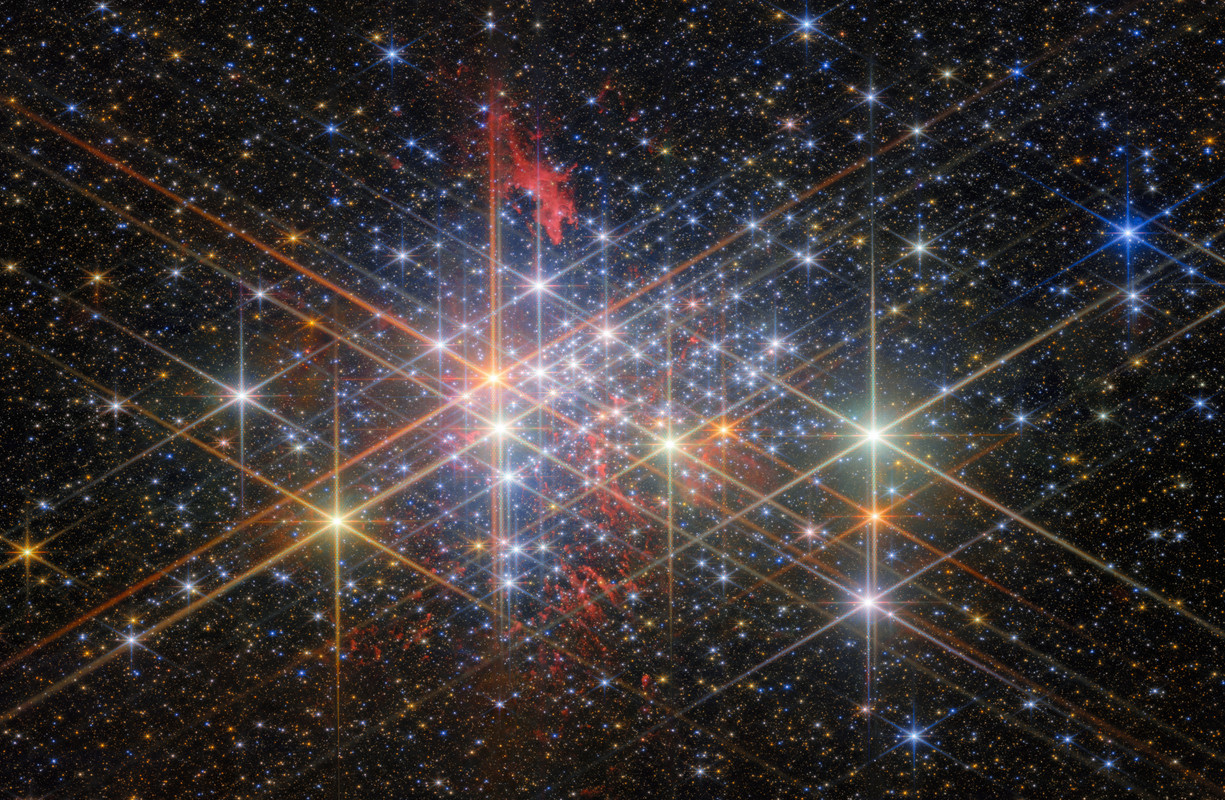
This image shows the center of the Serpens Nebula as seen by the NASA/ESA/CSA JWST’s Near-InfraRed Camera (NIRCam).
The Serpens Nebula, located 1300 light-years from Earth, is home to a particularly dense cluster of newly forming stars (about 100 000 years old), some of which will eventually grow to the mass of our Sun. Webb’s image of this nebula revealed a grouping of aligned protostellar outflows (seen in the top left). These jets are identified by bright clumpy streaks that appear red, which are shock waves caused when the jet hits the surrounding gas and dust.
Throughout this image filaments and wisps of different hues represent reflected starlight from still-forming protostars within the cloud. In some areas, there is dust in front of that reflection, which appears here in an orange, diffuse shade.
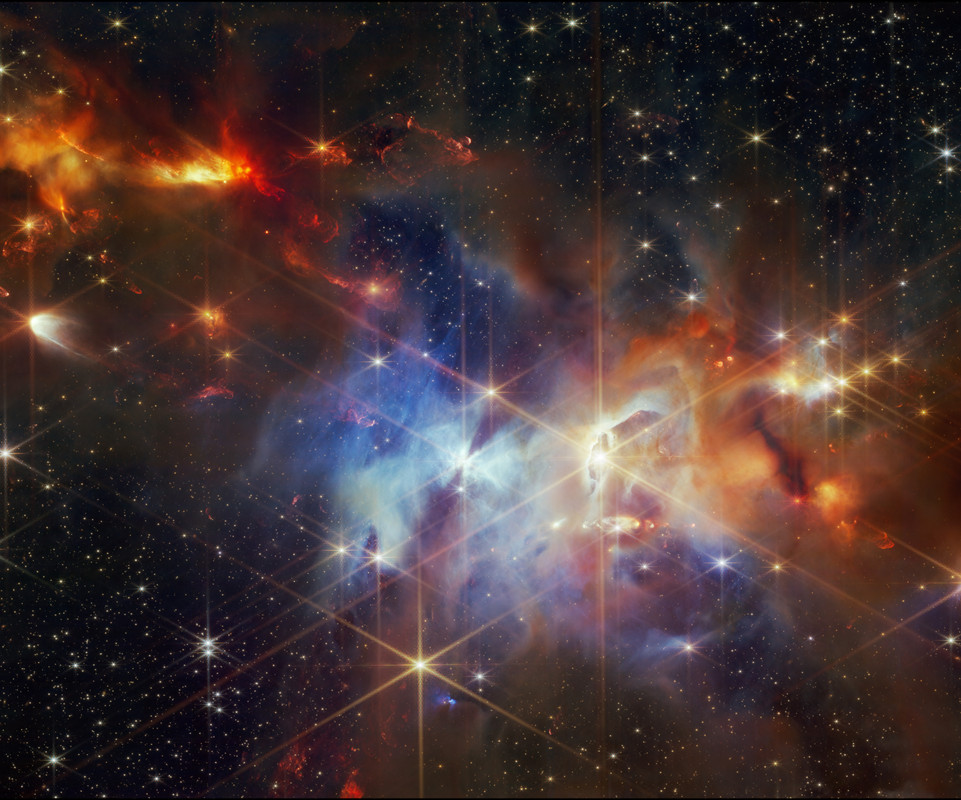
A high-definition image from the NASA/ESA/CSA JWST’s NIRCam (Near-Infrared Camera) unveils intricate details of supernova remnant Cassiopeia A (Cas A), and shows the expanding shell of material slamming into the gas shed by the star before it exploded.
The most noticeable colours in Webb’s newest image are clumps of bright orange and light pink that make up the inner shell of the supernova remnant. These tiny knots of gas, composed of sulphur, oxygen, argon, and neon from the star itself, are only detectable thanks to NIRCam’s exquisite resolution, and give researchers a hint at how the dying star shattered like glass when it exploded.
The outskirts of the main inner shell look like smoke from a campfire. This marks where ejected material from the exploded star is ramming into surrounding circumstellar material. Researchers have concluded that this white color is light from synchrotron radiation, which is generated by charged particles traveling at extremely high speeds and spiraling around magnetic field lines.
There are also several light echoes visible in this image, most notably in the bottom right corner. This is where light from the star’s long-ago explosion has reached, and is warming, distant dust, which glows as it cools down.
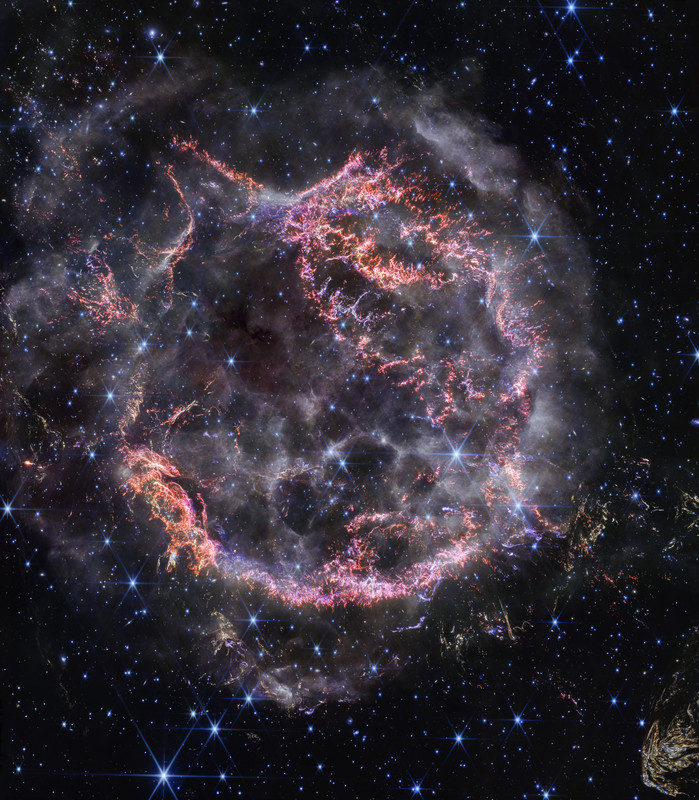
The bright red-pink spots correspond to regions rich in ionized hydrogen, which is due to the presence of newly formed stars. The diffuse gradient of blue light around the central region shows the distribution of older stars. The compact light blue regions within the red, ionized gas, mostly concentrated in the spiral arms, show the distribution of young star clusters.

The open cluster Westerlund 1, is located roughly 12,000 light-years away in the southern constellation Ara (the Altar) where it resides behind a huge interstellar cloud of gas and dust. It was discovered in 1961 from Australia by Swedish astronomer Bengt Westerlund. Westerlund 1 is an incomparable natural laboratory for the study of extreme stellar physics, helping astronomers to find out how the most massive stars in our Galaxy live and die.
The unique draw of Westerlund 1 is its large, dense, and diverse population of massive stars, which has no counterpart in other known Milky Way galaxy clusters in terms of the number of stars and the richness of spectral types and evolutionary phases. All stars identified in this cluster are evolved and very massive, spanning the full range of stellar classifications including Wolf-Rayet stars, OB supergiants, yellow hypergiants (nearly as bright as a million Suns) and luminous blue variables. Because such stars have a rather short life, Westerlund 1 is very young, astronomically speaking. Astronomers estimate the cluster’s age to be somewhere between 3.5 and 5 million years (its exact age is still a matter of debate), making it a newborn cluster in our galaxy. In the future, it is believed that it will likely evolve from an open cluster into a globular cluster. These are roughly spherical, tightly packed collections of old stars bound together by gravity.

This image shows the center of the Serpens Nebula as seen by the NASA/ESA/CSA JWST’s Near-InfraRed Camera (NIRCam).
The Serpens Nebula, located 1300 light-years from Earth, is home to a particularly dense cluster of newly forming stars (about 100 000 years old), some of which will eventually grow to the mass of our Sun. Webb’s image of this nebula revealed a grouping of aligned protostellar outflows (seen in the top left). These jets are identified by bright clumpy streaks that appear red, which are shock waves caused when the jet hits the surrounding gas and dust.
Throughout this image filaments and wisps of different hues represent reflected starlight from still-forming protostars within the cloud. In some areas, there is dust in front of that reflection, which appears here in an orange, diffuse shade.

A high-definition image from the NASA/ESA/CSA JWST’s NIRCam (Near-Infrared Camera) unveils intricate details of supernova remnant Cassiopeia A (Cas A), and shows the expanding shell of material slamming into the gas shed by the star before it exploded.
The most noticeable colours in Webb’s newest image are clumps of bright orange and light pink that make up the inner shell of the supernova remnant. These tiny knots of gas, composed of sulphur, oxygen, argon, and neon from the star itself, are only detectable thanks to NIRCam’s exquisite resolution, and give researchers a hint at how the dying star shattered like glass when it exploded.
The outskirts of the main inner shell look like smoke from a campfire. This marks where ejected material from the exploded star is ramming into surrounding circumstellar material. Researchers have concluded that this white color is light from synchrotron radiation, which is generated by charged particles traveling at extremely high speeds and spiraling around magnetic field lines.
There are also several light echoes visible in this image, most notably in the bottom right corner. This is where light from the star’s long-ago explosion has reached, and is warming, distant dust, which glows as it cools down.


Comet last seen by Neanderthals to brighten night skies – DW – 10/12/2024
Comet C/2023 A3 Tsuchinshan-ATLAS won't return for another 80,000 years, but astronomers say it could be visible to the naked eye this weekend.
vapviking
Old & In the Way
It sure is impressive, what a zillion dollars and a major ego can do.Oh my God. Elon Musk is an asshole and a major jerk as a human being, and I understand why so many hate him, but look what he did!!!


I don't decry space travel/exploration, I just wish Elon could be more human, less Ferenge.
But yeah, awesome video!
florduh
Well-Known Member
but look what he did!!!
He signed the checks. Engineers and other workers did everything else.
Here's what it takes to make the Starship work. Not one rich guy hopped up on ketamine.

cybrguy
Putin is a War Criminal
I know haters want to hate and you want to hate on anything that Elon Musk does. I don't like the guy either, but I have to respect his brilliance in industries that others have only dreamed about. Like it or not the truth is neither Tesla nor Spacex, both the leaders in their respective industries, would even exist without Elon Musk. And we would still be sucking the dick of the Russians to get to space. Somehow, I don't think that's a better alternative than having an ass push the science forward In both the space and auto industry.
So bitch and whine all you want, but Elon Musk has moved the ball in ways that no one has before. And I hope he will continue to do so.
So bitch and whine all you want, but Elon Musk has moved the ball in ways that no one has before. And I hope he will continue to do so.
Last edited:
florduh
Well-Known Member
I know you haters want to hate and you want to hate on anything that Elon Musk does. I don't like the guy either, but I have to respect his brilliance in industries that others have only dreamed about. Like it or not the truth is neither Tesla nor Spacex, both the leaders in their respective industries, would even exist without Elon Musk. And we would still be sucking the dick of the Russians to get to space. Somehow, I don't think that's a better alternative than having an ass push the science forward In both the space and auto industry.
So bitch and whine all you want, but Elon Musk has moved the ball in ways that no one has before. And I hope he will continue to do so.
I wouldn’t have said a goddamn word if you said “congrats to Elon and the SpaceX team”.
Not gonna address any of that other silliness but you should watch that Bill Burr clip.








